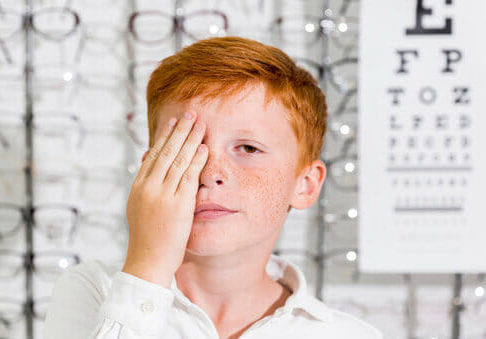Special Needs and Strabismus
Down Syndrome is a genetic disorder that can cause a range of physical and intellectual disabilities. It is one of the conditions that can increase the risk of developing strabismus, with estimates that between 20% and 60% of people with Down Syndrome have strabismus. In individuals with Down syndrome, the risk of developing strabismus may be due to genetic factors, but it can also result from other associated health conditions. Early detection and treatment of strabismus can help improve vision and prevent complications, so it is important to monitor the eye health of individuals with Down syndrome and schedule a functional or developmental eye exam if any symptoms of strabismus are present.
Cerebral Palsy is a group of neurological disorders that affects movement and muscle coordination. In some individuals with cerebral palsy, strabismus can also develop. This is because the disorder can cause abnormalities in the nerves that control eye movement and muscle coordination, leading to a misalignment of the eyes. Children with cerebral palsy have an increased risk of developing strabismus, and in some cases, the condition may worsen as they grow older. Treatment for strabismus in individuals with cerebral palsy may involve eye exercises, glasses, or in severe cases, surgery to correct the misalignment of the eyes. It's important to note that prompt and appropriate treatment can improve the visual function and quality of life for individuals with both cerebral palsy and strabismus.
Nerve that control eye movement and Strabismus
Cranial Nerve Palsies is a condition that can affect one or more of the nerves that control eye movement, leading to strabismus. Cranial nerve palsies can be caused by a variety of factors, including head injuries, strokes, or tumors. Treatment options for this condition may include surgery, eye patches, or glasses.
Duane Syndrome is a rare eye movement disorder that affects about 1 in 10,000 people. This condition occurs when the nerves that control eye movement are not functioning properly. As a result, affected individuals may experience difficulty moving their eyes in certain directions or may have a misalignment of the eyes. The condition is usually diagnosed in early childhood, and treatment options may include eye exercises or surgery.
Fourth Nerve Palsy is a condition that occurs when the fourth cranial nerve, which controls the movement of the superior oblique muscle, is damaged. Fourth nerve palsy can be caused by a range of factors, including head trauma, infections, and vascular disorders. Symptoms may include double vision, head tilt, and a misalignment of the eyes. Treatment options may include eye patches, prism lenses, and surgery to correct the muscle abnormality.
Sixth Nerve Palsy is a condition that occurs when the sixth cranial nerve, which controls the movement of the lateral rectus muscle, is damaged. Sixth nerve palsy can be caused by a range of factors, including head trauma, infections, and vascular disorders. Symptoms may include horizontal double vision, eye strain, and a misalignment of the eyes. Treatment options may include eye patches, prism lenses, and surgery to correct the muscle abnormality.









